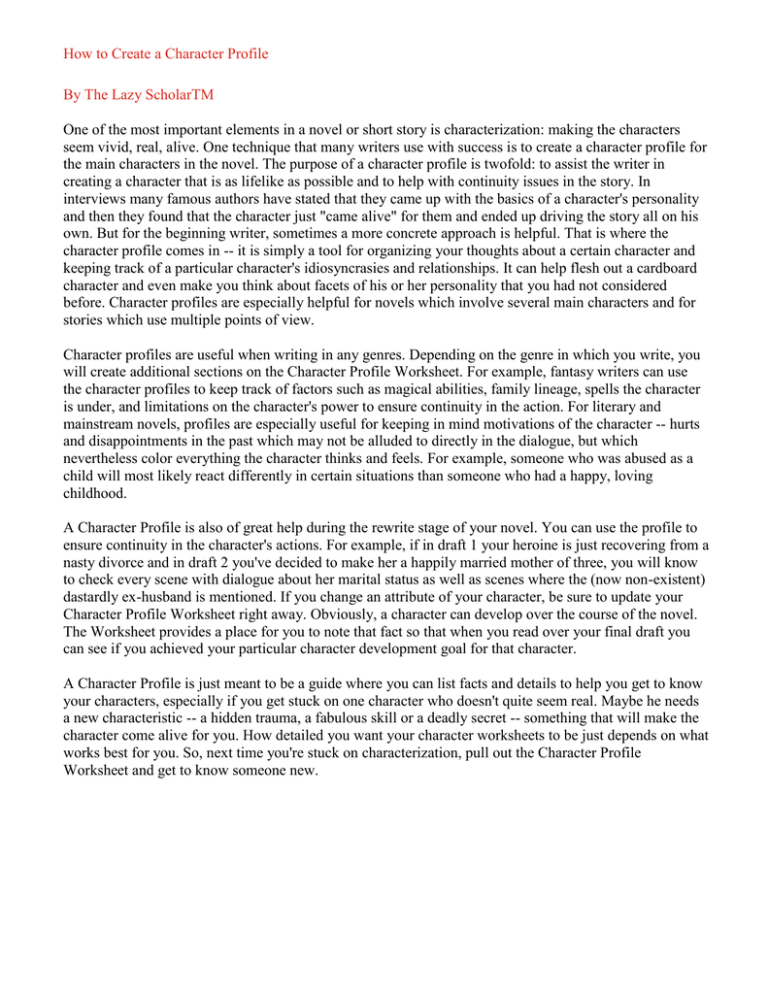How to Create a Character Profile By The Lazy ScholarTM
advertisement

How to Create a Character Profile By The Lazy ScholarTM One of the most important elements in a novel or short story is characterization: making the characters seem vivid, real, alive. One technique that many writers use with success is to create a character profile for the main characters in the novel. The purpose of a character profile is twofold: to assist the writer in creating a character that is as lifelike as possible and to help with continuity issues in the story. In interviews many famous authors have stated that they came up with the basics of a character's personality and then they found that the character just "came alive" for them and ended up driving the story all on his own. But for the beginning writer, sometimes a more concrete approach is helpful. That is where the character profile comes in -- it is simply a tool for organizing your thoughts about a certain character and keeping track of a particular character's idiosyncrasies and relationships. It can help flesh out a cardboard character and even make you think about facets of his or her personality that you had not considered before. Character profiles are especially helpful for novels which involve several main characters and for stories which use multiple points of view. Character profiles are useful when writing in any genres. Depending on the genre in which you write, you will create additional sections on the Character Profile Worksheet. For example, fantasy writers can use the character profiles to keep track of factors such as magical abilities, family lineage, spells the character is under, and limitations on the character's power to ensure continuity in the action. For literary and mainstream novels, profiles are especially useful for keeping in mind motivations of the character -- hurts and disappointments in the past which may not be alluded to directly in the dialogue, but which nevertheless color everything the character thinks and feels. For example, someone who was abused as a child will most likely react differently in certain situations than someone who had a happy, loving childhood. A Character Profile is also of great help during the rewrite stage of your novel. You can use the profile to ensure continuity in the character's actions. For example, if in draft 1 your heroine is just recovering from a nasty divorce and in draft 2 you've decided to make her a happily married mother of three, you will know to check every scene with dialogue about her marital status as well as scenes where the (now non-existent) dastardly ex-husband is mentioned. If you change an attribute of your character, be sure to update your Character Profile Worksheet right away. Obviously, a character can develop over the course of the novel. The Worksheet provides a place for you to note that fact so that when you read over your final draft you can see if you achieved your particular character development goal for that character. A Character Profile is just meant to be a guide where you can list facts and details to help you get to know your characters, especially if you get stuck on one character who doesn't quite seem real. Maybe he needs a new characteristic -- a hidden trauma, a fabulous skill or a deadly secret -- something that will make the character come alive for you. How detailed you want your character worksheets to be just depends on what works best for you. So, next time you're stuck on characterization, pull out the Character Profile Worksheet and get to know someone new. Character Profile Worksheet – Story Title: _________________________________________________ Basic Statistics: Name Age Nationality / Race Hometown Socioeconomic background Current Residence Sociology: Class Occupation / Income Educational Background Religion / Spiritual Life Intelligence Level Quality of Home Life Family Relationships (siblings, spouse, children, grandparents) Significant Others (friends, enemies) Physiology: Height / Weight / Sex General Health (disabilities, mental issues) Eye / Hair /Skin colour Mannerisms Speech Patterns Style of Dress Distinguishing Features Psychology: Hobbies Habits Talents / Skills / Abilities Attitude towards life Personal Goals (short term, long term) Temperment / Nature / Qualities Moral Standards Sources of Frustration Fears What would most embarrass the character? How does the character see him/herself? How does the character believe he/she is perceived by others? What would the character life to change in his/her life? What is the character’s level of self confidence? Why? What is the most significant event in the character’s life? Does the character seem ruled by emotion or logic or some combination thereof? How the Character is Involved in the Story Character's role in the novel (major, minor, hero, heroine) Scene where character first appears Relationships with other characters in the story Additional Notes on This Character: Motivations